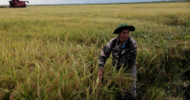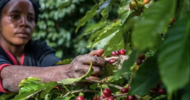In areas with dense populations, the land is closely tied to the housing market. But in places like the Midwest, however, the value of farmland rises in closer step with farm incomes, which climbed in 2020 and even higher in 2021, reflecting rising corn and soybean prices and hefty government payments for commodity farmers (due to trade and coronavirus relief).
“So, when corn and soybean prices are high . . . . farmers have more cash, so they’re more likely to bid up the price,” said Chris Laughton, who works at Farm Credit East, the Northeast’s largest agricultural lending cooperative.
But in the Northeast, “there is way less commodity farming and more things like fruits and vegetables and horticulture,” said Laughton. The region’s many small-scale farmers have received much less in emergency relief over the last several years. And while it’s hard to pinpoint the exact pressures on Northeast farmland based on the transactions he’s observed, Laughton points to both prosperous local markets and the pressure from people seeking rural housing.
These trends will likely continue. “Depending on the location, I think farmland values are continuing to go higher, at least in New England,” said Laughton. Based on Farm Credit East’s transactions, he estimates that farmland prices in the region have risen between 5 and 15 percent this year, depending on the location and quality of land.
The Impact on Young and Beginning Farmers
American Farmland Trust (AFT) found that 11 million acres of agricultural land has been “paved-over, fragmented, or otherwise converted to new uses that jeopardize farming” between 2001 and 2016. In New England, the vast majority of the converted farmland—85 percent—was lost in metropolitan counties, which often “feature broader peri-urban and even semi-rural landscapes within them,” according to an AFT report.
In an unfortunate overlap, the most vulnerable regions to development also tend to be home to farmers who are already struggling with land access. “There’s a consistent trend for farmers of color and new and beginning farmers to exist in these peri-urban and metro-adjacent areas,” said Laura Barley, the manager of AFT’s Farms for a New Generation program and the report’s author. And the pressure on these regions has only intensified over the last two years.
Case in point: Since the pandemic’s onset, Ryan Hvizda, the owner of Hvizda Realty Group in New Hampshire, has observed more cash buyers waiving inspections to secure properties more quickly—an option that isn’t available to most farmers who must have the property appraised to receive a loan.
“That just pushes [farmers] completely out of the market because you have somebody coming in with cash, no contingencies,” said Hvizda.
In New York’s Hudson Valley, home of the nation’s two most popular towns to relocate to during the pandemic, agricultural real estate has skyrocketed in the last year. According to the Ulster County Board of Realtors, which represents multiple counties in and around the valley, the number of farmland sales there went up by 16 percent and the average sale price has increased by 32 percent, between January 1 and December 8 of 2021.
As the real estate boom extended north of the Hudson Valley, Sarah Kingzack, who runs KZ Farm on 48 acres near the town of Westport, overlooking Lake Champlain, saw her hopes of expanding the operation dashed as she witnessed what she calls a “land grab.”
When Kingzack and her partner bought the land in 2016, they hoped to eventually expand their grass-fed cattle and organic vegetable farm into the land abutting their property.
“In the midst of all this, we’re thinking, “Oh my goodness, it might be now or never for the hayfield next door,” said Kingzack. So, they initiated a conversation with the owner of the land about purchasing it. But soon after, the owner contacted their neighbors—who don’t have a farm, or any intention of farming—and sold the land to them, instead.
Similarly, in Connecticut, Robert Chang watched as the historic farmland across from the 14-acre property where he grows produce and flowers at Echo Farm climbed to a price well out of his budget: over $28,000 per acre. Before the land went up for sale, he expressed to the current landlord his interest in purchasing it, hoping to expand his farm. But the current price makes that impossible.
“You’d have to find some very wealthy angel to come in to try to save it for farmland and that’s not likely to happen. But I’m hoping for a miracle,” said Chang.
Beyond his own interests, Chang is troubled that the land will likely end up in the hands of wealthy non-farming landowners, which he says is “not really the future for agriculture I want.”
The 39.7 acre property, listed by LandVest, is currently on sale for $1.15 million. It is advertised as “gently sloped acres . . . offering its abundant hay to clouds and sun and local farmers.” Not long ago, the land was part of a 92-acre dairy farm, whose owners sold 14 acres to Chang (after he wrote them a letter asking for a lower price). The remaining 78 acres went to a real estate investment company.
Escape Plans and Second Homes
Jennifer Ifft, an associate professor in the department of agriculture economics at Kansas State University, describes the high farmland values in the region as largely reflecting “demand for development of rural properties and rural homes.”
The Northeast’s housing appeal may also be driven by fact that the region is being seen as a potential haven from the worst impacts of the climate crisis, suggested Nina Young, a realtor with Maine Farms Realty and the Maine Farmland Trust. Young has observed generations of families moving to Southern Maine and buying historic farmland to live on for the long-term—a move she sees as a way to take shelter from both COVID-19 and climate change. “The air is cleaner here,” said Young. “We generally have plenty of water in Maine.”
While Maine and the Northeast are threatened by climate change, especially increased flooding, the region is less vulnerable to the intensified droughts, dangerously high temperatures, and wildfires that routinely wipe out crops and endanger farmers’ lives in other states.
This trend toward hobby farms and climate escape plans adds to the number of actual farmed acres that will be taken out of commission, while contributing to the rising cost of farmland. “As non-agricultural factors really begin to influence the value of the land, it makes it harder for new and beginning farmers to be able to justify paying for that land,” said Nathan L’Etoile, who leads AFT’s programs in New England.
When this happens, farmland effectively moves to a market, one that isn’t for commercial farmers.
Already, there are many historic farm properties in the Northeast that are sold as luxury properties, aimed to serve as country estates or investment properties. The high-end agriculture and forestry real estate company LandVest specializes in this kind of real estate, advertising farms under “lifestyle” properties.
“The buyer pool is into this recreationally, though we do get some folks who are committed agricultural people,” said Slater Anderson, the vice president and managing director of real estate at LandVest.
A handful of LandVest’s properties advertise prime agricultural soils. For instance, a 206-acre historic tobacco farm with “95 acres of prime agricultural soils and 58 acres of soils of statewide significance, predominately Enfield and Ninigret silty loams,” unprotected by a conservation easement, is currently on sale for $2.85 million in Southwick, Massachusetts. According to deed records, the parcel has been an investment property for decades. It also serves as a telling example of the way land has moved through the current asset economy.
In 1953, the property was deeded to General Cigar Company, the world’s largest cigar manufacturer, which changed its name to Culbro Corporation in 1976. In 1997, Culbro Corporation transferred the property to Culbro Land and Resources LCC, which changed its name to Griffin Land and Nurseries in that same year and then changed it again in 2015 to Indus Realty Trust, which acquires, develops, and owns properties in “high-growth, supply-constrained markets.”
Indus Realty Trust’s stockholders include BlackRock and The Vanguard Group, which means that the world’s largest asset managers have been indirectly profiting from Massachusetts’s most fertile soils—and they’re now for sale. The realtor for the property told Civil Eats that he sought out conservation groups with hope that they can collectively pool their resources to purchase it, although whether that will actually be feasible remains to be seen.
Land Sharing on the Rise
After a year of searching, Gabriela Pereyra eventually did luck into land ownership, purchasing a 20-acre parcel that checked off most of her boxes. In a few years, she intends to move the land to a model of collective ownership where others can share and help cultivate the property, while inviting her larger community to connect in other ways to the land.
“Our community is Black and Indigenous queer folks who wants to be in relationship with the land—that doesn’t necessarily mean farming per se but also using the land as a safe space for our close circle,” said Pereyra.
Other more formal forms of collective land use have emerged in recent years, giving farmers more options than renting and owning land, while moving beyond thinking of land as a transactional commodity.
For instance, Minnow aims to secure long-term land tenure for people of color in California through collective and Indigenous governance. Neil Thapar, the project’s co-director, notes that they’re currently developing a land trust with tribes in Mendocino County. And the Agrarian Trust places farmland in collective trusts, known as local “agrarian commons,” where instead of holding a title to the property, farmers own a multigenerational lease.
NEFOC has been supporting the development of land stewardship cooperatives, which has so far been a more common model for housing. “We’re finding collectivity is really key,” said Morningstar, “not only for pooling financial resources but also for pooling labor and creating a community of care.”
Like Minnow, NEFOC is working to build understanding and agreements with Indigenous people, prioritizing returning the land to its original stewards. So far, they’re a “land trust without land as we build trust,” Morningstar said.
More recently, the Every Town project, launched by Kenya Lazuli who works at NEFOC and co-founded Radical Imagination, emerged in Vermont during the pandemic. It aims to secure at least one parcel of land or building in every town in the state to be “held in trust for permanent stewardship and access for Black, Indigenous, and people of color.”
As farmland prices escalate, these emerging structures—though still few and far between—are intended to offer ways forward for many farmers left out of the opportunity to own land. Yet, of course, everyone working to improve land access for under-resourced farmers is swimming upstream, amidst a rush of investor and developer money and against the long tide of history.













